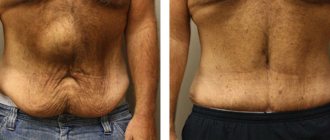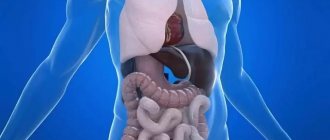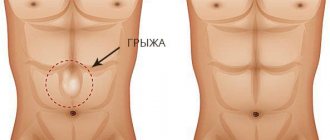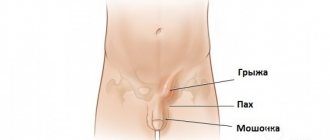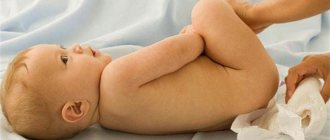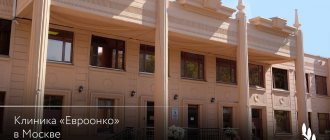What is an abdominal hernia?
Extension of the internal organs of the abdominal cavity and small pelvis through existing openings beyond their anatomical zone under the general outer covering or into another area is called an abdominal hernia. Unlike prolapse (loss) and eventration (depressurization), a hernial protrusion necessarily consists of three components:
- Gate (exit point).
- Sac (part of the peritoneum).
- Contents (internal organs and structures).
Most often, the hernial sac contains intestinal loops and the greater omentum.
The most important thing for the patient
The presence of a hernia of the anterior abdominal wall sharply limits a person’s capabilities, forces him to limit physical activity, constantly and carefully monitor the hernial protrusion, and wear special bandages.
But sometimes even these measures cannot protect a person from a strangulated hernia, which can occur unexpectedly (for example, having slipped, a person abruptly changes his body position, unusually straining his muscles, which can lead to a significant release of internal organs into the hernial protrusion, in which they can no longer straighten back). Eliminating the hernia once and for all relieves the patient of such problems. Our Clinic performs all types of surgical treatment of any hernia of the anterior abdominal wall. The type of operation is determined individually for each patient, taking into account many factors (location, type, size of the hernia, the patient’s age, the presence of concomitant diseases, the patient’s desire, his lifestyle and profession).
Classification
The classification will help you find out what hernias are:
- by origin - congenital and acquired;
- according to the presence of complications - free, chronically complicated (irreducible) and acutely complicated (strangulated, inflamed, etc.);
- according to the location of the hernial orifice - umbilical, periumbilical, inguinal, femoral, white line of the abdomen, perineal, lumbar, obturator, sciatic, Spigelian line;
- by structure - single- and multi-chamber;
- by quantity - single and numerous.
Only a doctor can accurately determine the type of abdominal hernia.
External
Hernias that come out along with the parietal layer of the peritoneum, as well as through “weak spots” in the muscle-tendon layer of the abdominal walls and pelvic floor, including without damaging the skin, are called external. Hernial orifices can form in natural anatomical areas (femoral ring, Petit's triangle and others) or in areas that have been negatively impacted (after operations, injuries, certain diseases).
Domestic
This type of abdominal hernia is characterized by an internal location. The pathology is localized in the pockets (folds) of the abdominal or thoracic cavity, penetrating through anatomical or acquired defects in the diaphragm.
Congenital
During the prenatal period, for various reasons, the abdominal wall of the abdomen is underdeveloped or its anomalies are formed. This becomes the basis for the formation of pathology.
Purchased
This type of abdominal hernia is formed during a person’s life. Under the influence of numerous factors, a hernial sac appears first. Then, under the influence of increased pressure in the abdominal cavity, internal structures and organs enter it and exit.
Complicated
The danger of such a disease as abdominal hernia (especially irreducible) is that it can suddenly lead to serious complications:
- final uncontrollability;
- inflammation, the “source” of which can be internal or external infectious agents;
- infringement;
- coprostasis;
- damage to the hernial contents (organ rupture, bleeding from an injured vessel, and so on).
Any exacerbation of an abdominal hernia is a reason to urgently seek medical help.
Uncomplicated
A hernia that occurs without complications is a disease that requires dynamic monitoring and treatment by a surgeon. It should be borne in mind that it can change its status at any time and become a complicated pathology.
Types of abdominal hernia
Depending on the anatomical location, typical (common) types of abdominal hernias and rare forms are distinguished. The most common hernias are:
- inguinal (75%);
- postoperative (12%);
- femoral (8%);
- umbilical (4%).
All other abdominal hernias account for no more than 1% of cases. Females are characterized by femoral and umbilical variants, males - inguinal localization.
Inguinal
There are hernias of the groin area:
- straight (more common in older people, a rounded protrusion is determined near the inguinal ligament);
- oblique (more often diagnosed in children and middle-aged men on one side, usually descending into the scrotum);
- sliding.
In the latter case, one of the walls of the hernial sac is an organ partially covered by the peritoneum (cecum, bladder). As the disease progresses, the function of the latter will suffer, and the person will begin to be bothered by characteristic complaints (constipation, impaired urination, etc.).
Umbilical
Most often, protrusions in the navel area are diagnosed in children, as well as women who are over 40 years old. In children, pathology easily develops due to underdevelopment of the umbilical ring. In women, the provoking factor is stretching of the muscular-connective structures of the abdomen during pregnancy and childbirth. In addition, an embryonic hernia of the umbilical cord is identified, associated with an anomaly of intrauterine development.
Femoral
Due to its anatomical structure, this abdominal hernia occurs much more often in women than in the opposite sex. It is located in the area of the triangle of the same name. Externally, there is a small hemispherical protrusion in the area of the femoral-inguinal flexure.
Hernia of the white line of the abdomen
Between the rectus abdominis muscles, humans have a small strip of tendon called the linea alba. It is in this area that characteristic protrusions appear. In men they occur between the ages of 20 and 40, slightly more often than in women (after 40 years).
Crotch
Hernia formations can be localized in front or behind the intersciatic line. They are observed mainly in women. The hernial sac may include the bladder or genitals.
Lateral
These hernias are formed along the Spigelian line and from the rectus abdominis muscles. They are difficult to differentiate. Often the patient first comes to the doctor with an infringement of the formation.
Prevention
To reduce the likelihood of a hernia forming or reoccurring, it is important to make lifestyle changes. First of all you should:
- stop smoking and minimize the amount of alcohol consumed;
- do exercise therapy and stretching exercises daily;
- undergo a course of manual therapy twice a year;
- avoid stress and change your attitude towards stressful situations;
- sleep at least 7–8 hours;
- wear high-heeled shoes no more than 2 hours a day;
- visit the pool twice a week;
- balance your diet, give up unhealthy foods and adhere to a normal drinking regime (at least 1.5 liters of water per day);
- take vitamins, especially group B and unsaturated fatty acids (Omega-3).
Symptoms and signs
The clinical picture will depend on the location of the protrusion and existing complications. More often, the symptoms of an abdominal hernia will be as follows:
- the presence of education itself;
- pain of varying intensity and character, with possible irradiation and intensification with physical activity, coughing, sneezing, increased gas formation and constipation;
- disruption of the functioning of the organs that make up the contents of the hernial sac.
If complications occur, corresponding symptoms will appear. Sometimes, in addition to physical complaints, patients are concerned about aesthetic discomfort associated with the presence of an external defect. This can trigger emotional problems and depression.
Treatment of abdominal hernia
The only method to cure the pathology is surgery. Unreasonable use of a bandage only contributes to injury to the abdominal hernia and the development of complications. The likelihood that a reducible protrusion will become irreducible increases. Wearing a bandage is recommended only for people who have contraindications to surgery. The latter include:
- age up to one year;
- acute infectious processes in the body;
- chronic diseases and infections in the acute stage;
- oncological diagnosis (except for stable remission);
- pathology of the blood system;
- serious diseases in the stage of decompensation (diabetes mellitus, cirrhosis of the liver, etc.);
- recently suffered strokes and heart attacks, other “severe” conditions.
The operation should not be performed on pregnant women.
Surgical intervention
There are many options for surgical techniques for this pathology. If complications occur, emergency intervention is indicated. For uncomplicated abdominal hernias, elective surgery is performed. It includes the following steps:
- dissection of tissue over the hernial formation and the area of the hernial orifice;
- isolation and opening of the hernial sac;
- return of internal organs “to their place”;
- stitching and ligation of the neck of the hernial sac, its removal;
- strengthening the abdominal wall with your own tissues or special means;
- layered sutures.
Surgery can be performed under local or general anesthesia.
Folk remedies
When an abdominal hernia hurts, what to do and what absolutely cannot be done - only a doctor can answer. This disease should not be treated at home using traditional recipes, as there is a high probability of complications arising from this background. Amateur activities are especially dangerous for young children. Methods such as applying a coin to the umbilical hernia in infants and others cannot replace medical consultation.
Massage for some forms of hernia
If a patient has a high probability of developing a hernial protrusion in the abdominal area, therapeutic massage is an excellent means of prevention. Daily tummy massage is recommended for all infants in the absence of medical contraindications. Massage procedures are also recommended for all women after childbirth. They are also prescribed after hernia repair so that the body recovers faster and to prevent relapse. You cannot perform a massage if there is a formed hernial formation without a doctor’s permission.
Rehabilitation period
If a hernia in the abdomen was removed laparoscopically as planned, rehabilitation will be much easier and faster than after abdominal surgery for a complication caused by it. Therefore, surgeons insist that there is no point in delaying the operation if there are direct indications for it.
After surgical treatment, the patient remains in the ward for several hours or days, under the supervision of medical personnel. He is then discharged home. Further rehabilitation includes:
- walking and physical activity comparable to the intervention;
- nutritious food with enough fluids;
- body weight control;
- walks in the fresh air three days after surgery;
- mandatory dressings;
- taking medications prescribed by a doctor (antibiotics, laxatives, etc.);
- wearing special postoperative underwear;
- You should not bend forward, do gymnastics, lift weights and provoke an increase in intra-abdominal pressure.
To prevent relapses, even after final recovery, it is advisable to adhere to these recommendations.
Features of anatomy
The entire spine is formed by more than 30 vertebrae of different sizes and is divided into 5 sections:
- cervical - formed by 7 vertebrae (C1–C2), which are the smallest and most mobile in the body;
- thoracic - formed by 12 vertebrae (Th1–Th12), least likely to be susceptible to degenerative-dystrophic changes;
- lumbar – consists of the 5 largest vertebrae (L1–L5), which bear the greatest load during physical work;
- sacral – has 3 vertebrae (S1–S3);
- coccyx – formed by 1–3 fused vertebrae.
Between all the vertebrae there are cartilaginous structures that provide shock absorption when walking and the natural flexibility of the spine. They are called intervertebral discs. Each disc has a pulpous nucleus pulposus and a tough outer shell called fibrous. It is protected on the sides by end plates.
